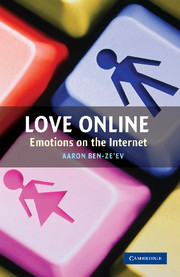Book contents
- Frontmatter
- Contents
- Preface
- 1 The seductive space
- 2 The paradoxical nature of online relationships
- 3 Emotions on the Net
- 4 Online imagination
- 5 Online privacy and emotional closeness
- 6 Is it worth it?
- 7 Flirting on- and offline
- 8 Cyberlove
- 9 Chatting is sometimes cheating
- 10 The future of romantic relationships
- Notes
- Bibliography
- Index
10 - The future of romantic relationships
Published online by Cambridge University Press: 22 September 2009
- Frontmatter
- Contents
- Preface
- 1 The seductive space
- 2 The paradoxical nature of online relationships
- 3 Emotions on the Net
- 4 Online imagination
- 5 Online privacy and emotional closeness
- 6 Is it worth it?
- 7 Flirting on- and offline
- 8 Cyberlove
- 9 Chatting is sometimes cheating
- 10 The future of romantic relationships
- Notes
- Bibliography
- Index
Summary
Give me chastity and continence – but not yet.
Augustine's plea to GodIt is hard to predict the future – for one thing, the future (as Paul Valéry said) is not what it used to be. Indeed, many past predictions now provide us with amusing reading. Thus, an 1868 survey of traffic in Victorian London seriously estimated that vehicular traffic would squelch to a nasty halt by 1925 because the roads, by then, would be covered in horse manure to a depth of 12.652 feet In 1977, Ken Olsen, President of Digital, made a similarly mistaken prediction when he famously remarked: “There is no reason for any individual to have a computer in his home.” Accordingly, I do not intend to present a detailed forecast of romantic relationships. However, when examining past and present circumstances – and in particular some of the new processes elicited by cyberlove – it is possible to anticipate a few of the tendencies that are likely to emerge in the future.
Stability and change in romantic relationships
Some people ask the secret of our long marriage. We take time to go to a restaurant two times a week. A little candlelight, dinner, soft music and dancing. She goes Tuesdays, I go Fridays.
Henry YoungmanEmotional meaning is generated by the interplay between stability and change. Emotions typically arise when we perceive significant changes in our personal circumstances.
- Type
- Chapter
- Information
- Love OnlineEmotions on the Internet, pp. 223 - 248Publisher: Cambridge University PressPrint publication year: 2004



